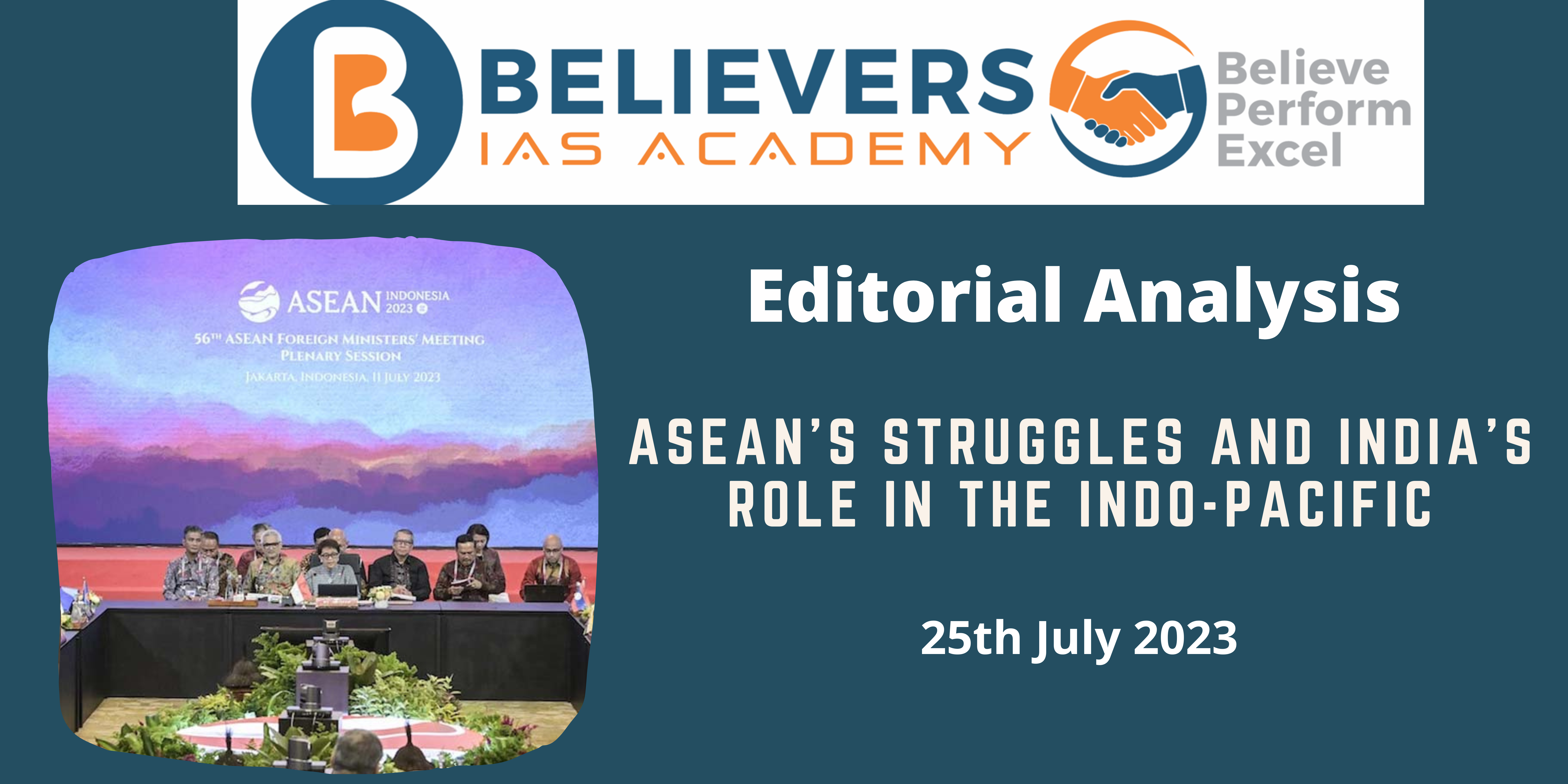ASEAN’s Struggles and India’s Role in the Indo-Pacific
Context:
Recently, the 56th Foreign Ministers Meeting (FMM) of ASEAN was held in Jakarta, Indonesia, scrutinizing the impact of critical geopolitical factors on the region. The article also delves into ASEAN’s vision for unity, and the significance of India’s role in the Indo-Pacific equation.
Relevance:
GS-02 (India’s foreign policy, International relations)
Prelims:
- ASEAN
- Member countries
Mains Question:
- Discuss the challenges faced by the ASEAN in navigating the complex dynamics of the Indo-Pacific region. Analyze the impact of geopolitical tensions, the role of major players, and the significance of India’s engagement in the region. (250 words)
Dimensions of the Article:
- ASEAN’s Brave Attempts Amid Transformative Changes
- Maintaining Unity Amidst Global Turmoil
- ASEAN’s Dilemma in the South China Sea
- Geopolitical Crossfire in the Indo-Pacific
- ASEAN’s Attempt at Mitigating Tensions
- ASEAN’s Struggle with Unity on Myanmar
ASEAN’s Brave Attempts Amid Transformative Changes
- The 56th Foreign Ministers Meeting (FMM) of ASEAN, held in Jakarta, Indonesia, in mid-July 2023, served as a barometer to gauge the ever-evolving dynamics of the Indo-Pacific, the heart of Southeast Asia.
- Within this complex web of strategic contestation, ASEAN’s institutional architecture has emerged as an inclusive platform, drawing nations from far and wide, along with major players such as the United States, China, India, Japan, and Russia.
- The joint communiqué of the FMM revealed ASEAN’s vision, aiming for a political community promoting regional peace, a well-integrated economic community, and a socio-cultural community focused on sustainable development.
Maintaining Unity Amidst Global Turmoil
- Addressing fellow Foreign Ministers, the Indonesian Minister for Foreign Affairs, Retno Marsudi, emphasized two critical factors essential for ASEAN’s success: adhering to the ASEAN Charter to maintain credibility and staying in the driver’s seat while navigating the ever-changing regional dynamics.
- However, achieving these noble goals has become increasingly difficult as internal differences on issues like Myanmar continue to surface. Furthermore, the strained relationship between the United States and China poses a serious challenge to ASEAN’s desire to lead the region and shape its agenda.
ASEAN’s Dilemma in the South China Sea
- China’s deep-rooted political and economic ties with several ASEAN states, particularly Laos, Cambodia, and Myanmar, have turned them into virtual dependencies. Although the Philippines has displayed assertiveness in the South China Sea dispute, the central players – Indonesia, Malaysia, Singapore, and Thailand – favor a cooperative approach with Beijing.
- Consequently, no strong voice is raised against China’s delaying tactics in negotiating an enforceable code of conduct for the South China Sea, revealing a perplexing case of diplomatic doublespeak.
Geopolitical Crossfire in the Indo-Pacific
- As the United States and China engage in an acrimonious debate, ASEAN finds itself in the crossfire of geopolitical tensions. While China blames the US for the strained relations, citing its refusal to accept China’s ‘peaceful rise,’ the US no longer ignores China’s aggressive behavior in the Indo-Pacific and beyond.
- The NATO’s Vilinius summit communiqué clearly expressed concerns over China’s ambitions and coercive policies, challenging the interests, security, and values of the democratic nations.
ASEAN’s Attempt at Mitigating Tensions
- To cope with intensifying geopolitical tensions, ASEAN looks towards the ASEAN Outlook on the Indo-Pacific (AOIP) as a potential solution.
- Focused on maritime cooperation, connectivity, UN Sustainable Development Goals 2030, and economic collaboration, the AOIP seems promising.
- However, its practical implementation remains a cause for concern, casting shadows on ASEAN’s ability to effectively address regional challenges.
ASEAN’s Struggle with Unity on Myanmar
- While ASEAN reiterates its centrality, internal disagreements over the sensitive Myanmar situation undermine its credibility. This issue has led to the exclusion of Myanmar from all political-level discussions within ASEAN.
- Thailand’s independent dialogue with the military government, defying ASEAN’s official policy, has further revealed the group’s internal divisions.
- The routine reaffirmation of the Five-Point Consensus (5PC) forged in April 2021 fails to conceal this disunity, leaving ASEAN’s centrality vulnerable and weakened.
Way Forward:
As geopolitical complexities loom large in the Indo-Pacific, ASEAN must take proactive steps to maintain its relevance and credibility. Emphasizing unity and collective action is imperative in addressing regional challenges effectively. Engaging major players, including India, in fostering cooperation on issues like cyber, financial, and maritime security, can contribute significantly to mitigating tensions in the region.




